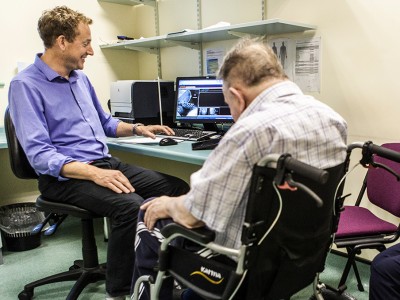‘Patient and public engagement’ has often reduced the role of patients to providing feedback (surveys, focus groups) or being a ‘representative’. The Partnership recognises that people who use our services can be collaborative partners. They are critical friends and insightful supporters who draw on wisdom, born of living with pain and suffering, loneliness and vulnerability, resilience and passion. Their healthcare experiences can lead to a leadership vision of care derived from seeing what’s working and what’s not. Their expertise goes way beyond ‘telling stories’ and is equal to, and different from those within the system.
We are growing a network of patient and carer partners (PCPs) and staff who learn from each other to re-frame problems, bring new insights and solutions, shift policy and practice, change dynamics. This aids accountability, transparency, quality and safety. We have a growing band of Patient and Carer Partners (PCPs) working on improvement activities:
- PCPs on a pain service redesign programme helped to pilot a ‘pain education session’ for new patients and ideas for peer to peer support
- Patients and administration staff are working together to design and run training sessions for call handlers
- Having patients involved in how we measure outcomes has led to improvements in data gathering (particularly how we gather data in secondary care)
- Patients will co-deliver training for clinicians in how we provide a holistic service for people with both physical and mental health issues
- During a workshop on administration systems, a patient partner suggested we move to an ‘opt-in’ process whereby we ask people to call in to make appointments. We are rolling this out and it should save about 3,000 cancelled appointments per year
As we get to know each other better, people’s talents surface. One sees “frozen assets” thawing and leads work on capturing learning and raising awareness of partners’ skills: “I am getting my confidence back” she says. Another, drawing upon professional skills has produced a partner welcome pack. She is also developing a database of ‘patient volunteers’ – about 200 people who have offered to be involved in wider engagement work.
Our appointment letters are more user-friendly, and include prompts to allow people to better prepare for a consultation. Feedback shows these to be popular amongst clinicians and patients. Not surprising, since they were designed by patients and staff!
Patient Partners are part of the ‘Culture Club’ group that focuses on our values and visions. They ran workshops at our staff event. And at a rheumatology away day, a patient-led session was seen as “possibly the most insightful” of the day. It led to staff discussing their own ill-health and current pressures.
In terms of governance, we have patient and carer partners included in ‘quality summits’ that look at what we are doing well, and could be better. This will be important as we prepare for CQC inspection. One Partner sits on our ‘clinical quality group’ and three multi-disciplinary teams (spine, physiotherapy, pain) will include (new) patient partners in the next few months.
The challenge for partners is not easy – to steer between being ‘critical friend’ and ‘supportive ally’ – ask difficult questions, bring conversations back to what matters. This also involves using one’s own story ‘judiciously’, knowing when it provides illumination, being careful not to imply that this is the view of all.
The group as a whole is changing its spots. Mark Cannon, our Director of Primary Care Development and a member of our Enabling Team is helping us explore how systems thinking can aid planning. PCPs could become mentors and catalysts for collaborative leadership.
This is about ‘trialogue’ – three-way relationships at all levels. During care and treatment, good experiences are about the clinical and non-clinical encounter – between patients and healthcare professionals, and also support staff (call handlers, receptionists). At leadership level, we have a Clinical Director, a Managing Director and a Patient Director. In all the work, described above, we are trying to create spaces for ‘trialogue’ between clinical staff, administrative/managerial staff and patient and carer partners.
In all this, there are difficult conversations. One clinician noted power imbalance: “I gave a potted CV as my intro. The partner disclosed so much and made herself vulnerable.” But this cuts both ways. One clinician said: “It’s not easy to admit that I don’t know the answers or am not in control or able to influence things as much as I want to. I feel vulnerable too”. A partner responded: “It is all about honesty. This sort of transparency actually gives me more confidence in the service and what it is trying to do”.
The role of Patient Director is to broker conversations and hard wire patient partnerships (including systems and processes, reimbursement policies, etc). But you can’t rush this stuff. Ultimately, it’s about the human element more than policies, process maps and systems.
The passion, courage and kindness shown by staff (admin and clinical) and fellow patients has shown me true partnership is possible. I see the steady rise of a new way of doing things – founded on the wisdom of those affected by health conditions. It is about friends – many of whom I have not met yet – who share the passion and commitment to help improve healthcare. It is about hope. Join us?
Contact David Gilbert to show your support in this work or to enquire further about our learning and progress in this area: david.gilbert3@nhs.net
Interested in discussing Systems Thinking? Contact Mark Cannon: mark.cannon2@nhs.net
You may also like

30.08.2017 | by Mary McAllister
Learning together at SMSKP conference 2017

28.10.2016 | by Mark Cannon
'What Matters' Medicine

06.07.2016 | by David Gilbert
The role of a Patient Director

